
In 2017 Emaho embarked on a regional water project to test the safety of the water in Rinpoche's Tehor region of Eastern Tibet. This year, 2018, we conducted another series of tests, making comparisons. ZaChoeje Rinpoche is looking at implementing green technologies that will allow critical development that does not adversly affect the unique Tibetan landscape, its people, and its culture.
Scroll down to read more about the 2017 project, one of the many we undertake to support Rinpoche and the Tibetan people.
Read about our work below, and go to the Photo Gallery to see photos of our 2018 expedition.
Tehor Tibet Water Project 2018
We are pleased to share with you the progress being made at ZaChoeje Rinpoche’s monastery and surrounding villages in his Tehor region of Tibet
The construction of ZaChoeje Rinpoche’s Tashi Ganden Chopheling monastery in his Tehor region of eastern Tibet began in 2013 and is now underway. Part of the planning process is to develop long-range community plans for the monastery and its neighboring communities. Rinpoche is looking at implementing green technologies that will allow critical development that does not adversely affect the unique Tibetan landscape, its people, and its culture. Using scientific methods to accurately define problems allows Rinpoche to prioritize areas of highest urgency and to develop effective and cost-efficient solutions.
Water is a cornerstone of life. The first question Rinpoche wanted to answer is, do the crystal-clear cold streams providing water to the monastery and surrounding villages meet the quality considered safe for washing and safe for drinking? In 2017 we launched Emaho’s Tibetan Water Project. We tested sites in and around a 400-square-mile area surrounding the monastery. (Please see our short article on Emaho’s Tibetan Water Project 2017).
This year, 2018, we tested almost all the same water sites as in 2017. Two senior monks now oversee the water project and will continue to monitor the water for sanitary risks. They will be the leaders in implementing green technologies as they are developed by our Emaho Tibetan Water Project Committee.
Water changes its composition from one season to another. Environmental considerations, as well as a host of other ever-changing scenarios, impact water quality. Using the World Health Organization’s standards, our results from testing in 2017 and 2018 gave us two scientific snapshots for what is considered safe. From the over 200 tests we conducted, the answers unequivocally showed the need to develop a plan that will continuously filter and provide safe water.
June Rains
The Tibetans say this year’s heavy June rains were unusual. On our visit, the mornings were cold but the days warmed by afternoon. Evening thunderstorms roared across the valleys, dumping rain. Cirrocumulus clouds often just laid down between hillsides, staying all day. The first week it snowed.
Baby yaks, horses, and lambs were trying to stand on wobbly legs, and baby birds weren’t yet fully feathered. Wild flowers were everywhere. There seemed to be more water this year than last. The streams were fuller. New streams flowed where they hadn’t last year.
One morning Samten Chophel, Tenzin Namgyal, and I headed out first on motorcycles and then on horseback to test a water site up in a high valley. It had rained the night before and the small animal trail we followed was steep and muddy. On the way Samten suddenly stopped and dismounted. He began digging a small hole to the side of the eroding trail. He came back, picked up a small worm that had been washed out onto the trail, and placed it in its new abode. We dismounted a number of times in order to relocate worms. To the monks it seemed as natural as breathing. Being from the hurried West, I saw the action as the sweetest of moments.
Water Quality Findings
This year we conducted 92 tests in contrast to 114 in 2017. 41 percent of the water we tested in 2017 did not meet the World Health Organization’s standards for safety. This year the percentage jumped to 52% that were not safe.
Until we come up with an efficient, cost-effective system for treating the water, the monks are advising people to boil water before using.
Emaho's Geshe Lobsang translated into Tibetan an introduction to Rinpoche’s long range community planning, describing the problems he hopes to address and the solutions he hopes to implement in and around the monastery. The Tibetan article also has a section on basic hygiene and its importance to health. The article contains information on understanding germs, the transmission of germs, how germs impact our ability in staying healthy and how to stop their spread. We made signs in Tibetan to be placed in community areas to remind folks when to wash their hands, posters showing how germs are transmitted, the cycle of hygiene, and notices to boil water before using.
During a break in our water testing this year, Samten Lobsang was shown how to wash his hands using the techniques as set forth by the United States Center For Disease Control. He will share the techniques with senior monks who will share with junior monks who in turn will teach families in the numerous communities. We supplied 150 bars of soap to kick off the beginning of education about hygiene.
Green Technology for Tibet
The building of the new monastery is coming along, more spectacularly every day. From last year to this, third and fourth floors have been added and painted, the grounds have paved driveways and, to be more convenient and efficient, the monastery medical center has been moved down the road near the monastery store across the river from a number of populous villages.
Rinpoche asked we investigate what eco-friendly, cost-effective, sustainable technologies we could implement for the monastery toilets that would be used by the monks, visiting scholars, and guests. Green technology is an encompassing term. It deals with using science and technology in order to protect the environment. We believe simple green compost toilets will best protect human health and the environment. This will be an interesting and hopefully a successful experiment of using composting toilets on a large scale. The monks will be able to share this cost-effective process with surrounding villages. The hope is that the success of the program could showcase the Tehor area as a leader in the area of living and working in harmony with nature for the benefit of all.
This year we took measurements, made plans for the monastery bathrooms, took inventory of local materials that could be utilized in construction, and made a list of hardware and materials we’ll need to purchase to begin and hopefully complete the construction in the summer of 2019.
Future Plans
ZaChoeje Rinpoche has an evolving list of projects for the monastery and his Tehor region of Tibet. Each project is a piece of the structure that will help ensure the continuation of the Tibetan people and the unique Tibetan culture that is on the verge of extinction. How fortunate for those of who have encountered Rinpoche in this life. May his life be long and prosperous.
Emaho
Tehor Tibet Water Project 2017
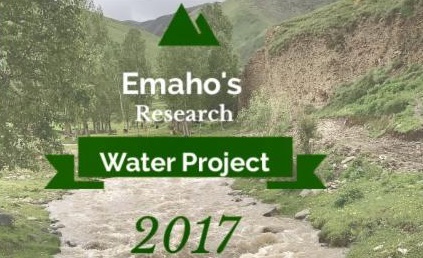
2017: Emaho embarks on a regional water project to test the safety of the water in Rinpoche's Tehor region of Eastern Tibet.
Read about our work below, and go to the Photo Gallery to see photos of our expedition.
The building of ZaChoeje Rinpoche's new monastery, Tashi Gaden Chopeling, is historically significant and awe inspiring. It's a work of love, spiritual attentiveness and exceptional beauty: every aspect is being created by hand.
Rinpoche is bringing useful Western technology to villages in his Tehor region of Eastern Tibet. This long-range community planning, now underway, will allow the exploitation of global technology without sacrificing the unique Tibetan culture that is currently on the verge of extinction. Mindfully merging the two worlds is master work.
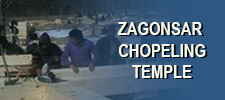
Early 2013: We are extremely pleased to report that ground has been broken for the new ZaGonsar Chopeling temple in Rinpoche’s Tehor, Tibet region. The generosity of donations from people like you have given the local people tools and materials to start building the new monastery foundation. Traditionally Tibet’s bitter winter keeps people indoors, but enthused men and women are out daily working on the project that symbolizes the first step in Rinpoche’s 25-year plan to bring sustainability to the community while preserving its precious culture.
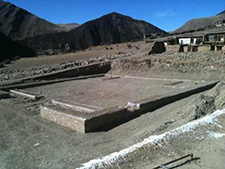

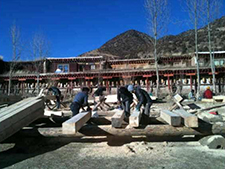
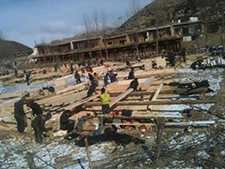

During Rinpoche's 2005 visit to TIbet a group of nuns asked for his guidance and patronage to support their sangha. Rinpoche was impressed by the dedication and perseverence shown by this group of women in their efforts to uphold the monastic tradition with such limited resources.
Rinpoche asked the surrounding community to help to construct a proper temple and residences for the nuns to live and practice together.
Recent reports stated that the main temple was nearly complete. Emaho has pledged to help provide resources so that this extraordinary group of women can continue to practice together.

During Rinpoche's visit to Tibet he made a huge impact on the families of that region. He saw that enrollment in the local school was very low and that the children were in need of supplies.
Rinpoche recommended that all families make a strong effort to enroll their children in school. As a result school enrollment jumped more than 200 percent.
Rinpoche also provided uniforms for some of the children and started a lunch program with a promise to provide more resources so that children could go to school and stay there the entire day.
